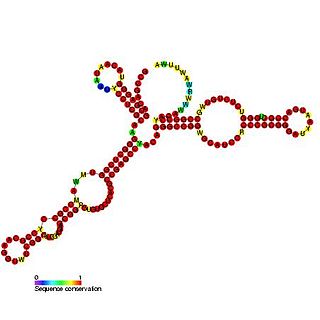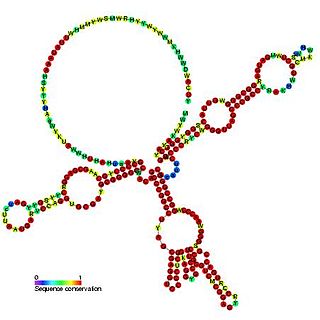
Pyrrolysine is an α-amino acid that is used in the biosynthesis of proteins in some methanogenic archaea and bacteria; it is not present in humans. It contains an α-amino group, a carboxylic acid group. Its pyrroline side-chain is similar to that of lysine in being basic and positively charged at neutral pH.

Chaperone proteins participate in the folding of over half of all mammalian proteins. In molecular biology, molecular chaperones are proteins that assist the conformational folding or unfolding and the assembly or disassembly of other macromolecular structures. Chaperones are present when the macromolecules perform their normal biological functions and have correctly completed the processes of folding and/or assembly. The chaperones are concerned primarily with protein folding. The first protein to be called a chaperone assists the assembly of nucleosomes from folded histones and DNA and such assembly chaperones, especially in the nucleus, are concerned with the assembly of folded subunits into oligomeric structures.

Ribonuclease H is a family of non-sequence-specific endonuclease enzymes that catalyze the cleavage of RNA in an RNA/DNA substrate via a hydrolytic mechanism. Members of the RNase H family can be found in nearly all organisms, from bacteria to archaea to eukaryotes.

Pyrococcus furiosus is an extremophilic species of Archaea. It can be classified as a hyperthermophile because it thrives best under extremely high temperatures—higher than those preferred of a thermophile. It is notable for having an optimum growth temperature of 100 °C, and for being one of the few organisms identified as possessing aldehyde ferredoxin oxidoreductase enzymes containing tungsten, an element rarely found in biological molecules.

Methyltransferases are a large group of enzymes that all methylate their substrates but can be split into several subclasses based on their structural features. The most common class of methyltransferases is class I, all of which contain a Rossmann fold for binding S-Adenosyl methionine (SAM). Class II methyltransferases contain a SET domain, which are exemplified by SET domain histone methyltransferases, and class III methyltransferases, which are membrane associated. Methyltransferases can also be grouped as different types utilizing different substrates in methyl transfer reactions. These types include protein methyltransferases, DNA/RNA methyltransferases, natural product methyltransferases, and non-SAM dependent methyltransferases. SAM is the classical methyl donor for methyltrasferases, however, examples of other methyl donors are seen in nature. The general mechanism for methyl transfer is a SN2-like nucleophilic attack where the methionine sulfur serves as the leaving group and the methyl group attached to it acts as the electrophile that transfers the methyl group to the enzyme substrate. SAM is converted to S-Adenosyl homocysteine (SAH) during this process. The breaking of the SAM-methyl bond and the formation of the substrate-methyl bond happen nearly simultaneously. These enzymatic reactions are found in many pathways and are implicated in genetic diseases, cancer, and metabolic diseases. Another type of methyl transfer is the radical S-Adenosyl methionine (SAM) which is the methylation of unactivated carbon atoms in primary metabolites, proteins, lipids, and RNA.

The HgcE RNA gene is a non-coding RNA that was identified computationally and experimentally verified in AT-rich hyperthermophiles. The genes in the screen were named hgcA through hgcG. The HgcE has been renamed as Pf3 and identified as an H/ACA snoRNA that is suggested to target 23S rRNA for pseudouridylation. This RNA contains two K-turn motifs. It was later identified as Pab105 H/ACA snoRNA with rRNA targets.

The HgcF RNA gene is a non-coding RNA identified computationally and experimentally verified in AT-rich hyperthermophiles. The genes were named hgcA through hgcG. It was later identified as Pab35 H/ACA snoRNA with rRNA targets.

The HgcG RNA gene is a non-coding RNA that was identified computationally and experimentally verified in AT-rich hyperthermophiles. The genes from this screen were named hgcA through hgcG. HgcG is of unknown function. hgcG is significantly similar to a region of the Archaeoglobus fulgidus genome. The genes were named hgcA through hgcG. It was later identified as Pab40 H/ACA snoRNA with rRNA targets.

Heat shock 70 kDa protein 1, also termed Hsp72, is a protein that in humans is encoded by the HSPA1A gene. As a member of the heat shock protein 70 family and a chaperone protein, it facilitates the proper folding of newly translated and misfolded proteins, as well as stabilize or degrade mutant proteins. In addition, Hsp72 also facilitates DNA repair. Its functions contribute to biological processes including signal transduction, apoptosis, protein homeostasis, and cell growth and differentiation. It has been associated with an extensive number of cancers, neurodegenerative diseases, cell senescence and aging, and inflammatory diseases such as Diabetes mellitus type 2 and rheumatoid arthritis.

Interleukin enhancer-binding factor 3 is a protein that in humans is encoded by the ILF3 gene.

DnaJ homolog subfamily A member 3, mitochondrial, also known as Tumorous imaginal disc 1 (TID1), is a protein that in humans is encoded by the DNAJA3 gene on chromosome 16. This protein belongs to the DNAJ/Hsp40 protein family, which is known for binding and activating Hsp70 chaperone proteins to perform protein folding, degradation, and complex assembly. As a mitochondrial protein, it is involved in maintaining membrane potential and mitochondrial DNA (mtDNA) integrity, as well as cellular processes such as cell movement, growth, and death. Furthermore, it is associated with a broad range of diseases, including neurodegenerative diseases, inflammatory diseases, and cancers.

Heat shock 70 kDa protein 1L is a protein that in humans is encoded by the HSPA1L gene on chromosome 6. As a member of the heat shock protein 70 (Hsp70) family and a chaperone protein, it facilitates the proper folding of newly translated and misfolded proteins, as well as stabilize or degrade mutant proteins. Its functions contribute to biological processes including signal transduction, apoptosis, protein homeostasis, and cell growth and differentiation. It has been associated with an extensive number of cancers, neurodegenerative diseases, cell senescence and aging, and Graft-versus-host disease.

DnaJ homolog subfamily B member 6 is a protein that in humans is encoded by the DNAJB6 gene.

Neuroendocrine protein 7B2 is a protein that in humans is encoded by the SCG5 gene. The protein expressed by this gene is widely distributed in neuroendocrine tissues. It functions as a chaperone protein for the proprotein convertase PC2 by blocking the aggregation of this protein, and is required for the production of an active PC2 enzyme. It is an intrinsically disordered protein that may also function as a chaperone for other aggregating secretory proteins in addition to proPC2. 7B2 has been identified in vertebrates and in invertebrates as low as flatworms and insects. It is also called Sgne1 and Secretogranin V. In C. elegans, it was originally called e7B2 and then renamed Seven B Two. There is a Pfam entry for this protein: Secretogranin_V (PF05281).

Methylosome protein 50 is a protein that in humans is encoded by the WDR77 gene.

DnaJ homolog subfamily C member 3 is a protein that in humans is encoded by the DNAJC3 gene.

60S ribosomal protein L18a is a protein that in humans is encoded by the RPL18A gene.

Histone-lysine N-methyltransferase SUV420H1 is an enzyme that in humans is encoded by the SUV420H1 gene. The enzyme along with WHSC1 is responsible for dimethylation of lysine 20 on histone 4 in mouse and humans.

DNA-directed RNA polymerase, mitochondrial is an enzyme that in humans is encoded by the POLRMT gene.

Archaeal transcription factor B is a protein family of extrinsic transcription factors that guide the initiation of RNA transcription in organisms that fall under the domain of Archaea. It is homologous to eukaryotic TFIIB and, more distantly, to bacterial sigma factor. Like these proteins, it is involved in forming transcription preinitiation complexes. Its structure includes several conserved motifs which interact with DNA and other transcription factors, notably the single type of RNA polymerase that performs transcription in Archaea.


















